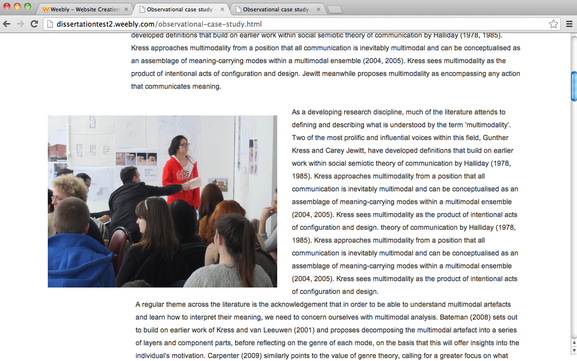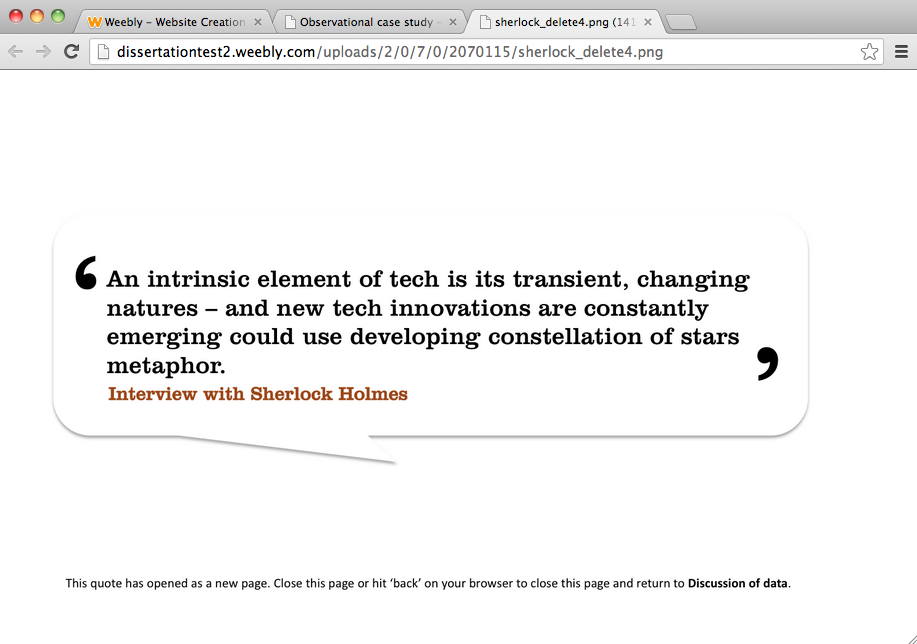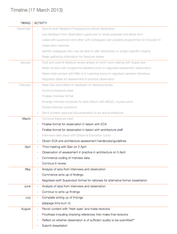|
Having revisited and then categorised the data from the seven interviews, I've rewritten the my original research questions (submitted within my 17 December Research Proposal). On reflection, questions 2 and 3 from my Research Proposal cover too much of the same ground. Also, the questions ignore the conditions that promote/discourage multimodal approaches to assignments, which has been one of more interesting themes to emerge from both the data and my lit review. I think the new combination of questions are also more able to directly address my overarching question posed within the dissertation. Anyway, I have gone... From this:
...to this:
0 Comments
Just a note of an idea before I forget it:
Hmmm. Not convinced. I think this might just be treading similar ground to the constellation map on the front page, thereby lessening the impact of the former. And even if I decide I like this, putting it in action will be dependent on time so might never happen.
File under 'abandoned ideas'. This won't be a video. I don't have the time to do it justice. Instead, I'll take photographs of university crests (containing a book) and will put them into a rolling slideshow, as I've just been testing out for the Observation section... If time allows, perhaps I could still try to create a single crest that is more multimodal (or digitally multimodal). That would be quite interesting.
Or perhaps I re-form one or more of the original crests to represent the multimodal university? Again though, I need to be conscious of time so this idea is probably unrealistic. Hi James
This all looks good - tidy and clear. There are a couple of v minor things on the attached. My bigger comment would be that there is no indication here of what critical argument you will be making, and no sense of how this will inform and structure the written text. It's good to be able to say in the introduction 'this is the argument I am making, and this is why', and then to be able to say in the conclusion 'this is how my argument has been made, and this is how I have demonstrated that it is important'. If you were going to define a single argument you will be making in this dissertation, what would it be? If you can define that and write it down in a couple of sentences, that can really help give 'spine' to the piece of work and a coherent sense of direction. Then, whatever meanderings happen in the individual chapters, the piece of work still has a clear trajectory. Possibly you are quite clear on this - it just didn't come through in the document. If it would help to just fire back to me the central argument (maybe try writing it down in less than 20 minutes : ) ) I can feed back quickly on that. I'm pretty sure you know what it would be - it's just a question of articulating it. let me know what you think? s It's back in! A combination of car travel and students missing appointments meant I had a bit of time to think and write about the observation and, on reflection, I think this could be a strong section. Or maybe it's the caffeine - I'll revisit this after this parents evening and see whether the idea is more or less flat than the cola.
Anyway, now that I've spent some time thinking about it, the section covering Observation of multimodal assessment in Architecture could be nice, short and take a sideways approach to the representation of ideas. Through the combination of text, images (individually embedded or perhaps as rolling sideshows) and the use of one or more Thinglink interactive images it could be a really interesting - and appropriate - way of presenting the gathered data. After all, why would I present an observation of multimodal assessment in predominantly conventional text form? Much better to try and match the representational to the content to be communicated. I also think would make for a more enjoyable and rich 'reader' experience. The observation would follow the Discussion and analysis of data section. It will consider what is observed both in relation to the collected data and also the literature. For instance, I'll think about common themes, differences and opportunities that emerge from the class asked practice that might inform the experience of online tutors. I won't go too heavy on the literature of reference to the data, partly to avoid repetition, partly due to word count and partly so that its more straightforward to write and read. I'm excited about this. I hope my enthusiasm sustains beyond the caffeine fix. Is there a way that, within my text, I can regularly hyperlink to quotes from the data?
This would be in addition to having key quotes reprinted in full. At least, I think it would. Or maybe that wouldn't be necessary. Maybe it would look a bit odd to have both. This might work by having linked text which, when clicked would open up a cut out diagram of the relevant quote, perhaps highlighted as itching a slightly larger part of the transcript, with the other text in faded grey. Ideally, a hover over would work better but I don't think that's possible from a text section in weebly. Maybe though the words could link to images - in a new page - at are themselves uploaded as documents. It'll be worth exploring this as its a more interesting way of presenting the research data and also better exploits the potential of hyperlinks. Actually, if this works, it would make sense to take the same approach when linking to relevant content within my blog (within the rationale section). So rather than linking to the whole blog post (where I would have to highlight the relevant text and tidy up/check what's around it) it would instead link to a cut out. In fact maybe I don't use actual cut outs but instead reproduce the text as if it has been lifted from the blog or transcript, allowing for accompanying biographical or background information as required. This could the date and title of the blog entry from which the text is drawn, and for the interview data. This should probably go in the discussion and analysis of data section.
I'll obviously link to the two artefacts (maybe from representatives image rather than just a text hyperlink) but alongside that I will need to offer a bit of background to the two artefacts, including in which ways they might be viewed a multimodal, how they differ, why I chose them, some very brief detail on the nature of the stipulated assessment exercise, the course they were a part of, what the assessment criteria was for the exercise. Rather than being at the start of the section, this would be part way through. Amongst other things it would be a nice way of breaking up that section (which will be text heavy). Also, it wouldn't sit well directly after the detail outlining the nature of the DE course that will at the beginning of this section. Is it worth taking the thinglink approach here, using the literature to highlight the different modes. Perhaps I would take a screen shot of each assignment with the overlaying information (thereby allowing for sound, through the volume icon). I've been thinking about how I could use this. Will there be room for it Witihin the main body of the dissertation? How and where will it fit in, without going over ground that has ready been covered? How much space should be allocated to it?
I could try and be quite imaginative with this. In my head I'd been thinking that this would be text and photographs. There's an opportunity though to do something more interesting. I could make the write up quite an interesting multimodal artefact in itself, as follows:
Another quite interesting idea... I could create some form of image (annotated photograph, manipulated photo, my own creation) to demonstrate the different modes being employed. This would almost be a scientific e.g. Medical, biological diagram. Maybe do this in thinglink: by hovering over different parts of the diagram, text appears naming the mode. THe pop Up text would be a combination of descriptive dialogue interwoven with literature, for instance a direct quote or a 'see for instance Kress 2001'. A bit like the maps for the NG project, I should take the original photo and do something interesting with it, not least as my own 'people shots' from the observation aren't particularly strong. AS this is in Eca/architecture, maybe I take an artistic or architectural approach to the image. Actually, the idea of architecture is good, although it could cause confusion with the constellation map if it ends up looking like a plan. Maybe just go for something interesting and artistic. It might be difficult to depict the artwork on a people image therefore maybe i create a composite in PowerPoint, with a 'model and sketches' image inset, which I then import to thinglink to make interactive. As per the use of videos within this dissertation, I don't want lots of accompanying explanatory text - this implies a lack of faith in the artefact. This image should work as a stand alone, therefore I'll have the smallest amount of text (as part of the wider text) and then have - 'see image' or perhaps not even that. A reply from Sian in response to my question about the use of video. I can't disagree with any of the below. Basically, it would be good, but its not necessary, and my priority should be the writing.
The video idea was already on hold until I get the writing out of the way, however it has been useful to have this reaffirmed.
I know I'm not supposed to be working on this until the writing is out of the way, however I had half an hour in a cafe over lunch so thought I might as well put it to use. Some thoughts on how the 'campus exploration' video might work:
What follows?
[Lunch ends] |
Categories
All
Archives
October 2013
TimelineOther stuff
|


